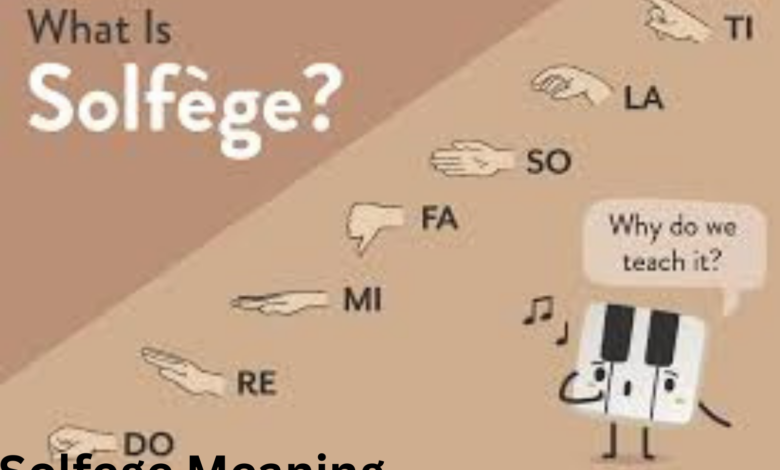Solfege Meaning Understanding the Basics of Music Notation

Have you ever hummed a tune and wished you could effortlessly translate it into notes on a page? Welcome to the fascinating world of Solfege Meaning! This musical language, rich in history and utility, opens doors for aspiring musicians and seasoned composers alike. Whether you’re looking to enhance your singing skills or understand music notation better, grasping the concept of solfege is essential. Join us as we explore its meaning, unravel its historical roots, and discover why it plays such a crucial role in music education today. Get ready to dive deep into this melodic journey!
What is Solfege?
Solfege is a system used to teach pitch and sight-singing through the use of syllables. Each note in a scale corresponds to a specific sound, making it easier for musicians to identify and reproduce melodies.
The most common form of solfege uses the syllables: do, re, mi, fa, sol, la, ti. These seven notes represent the major scale’s foundational pitches. By associating each tone with its unique name, musicians can internalize musical intervals more effectively.
This phonetic approach not only aids in vocal training but also enhances one’s ability to read sheet music. When singers hear “do,” they know it’s the tonic—home base for any melody. Solfege brings clarity and structure to music learning that transcends genres and styles alike.
The History of Solfege
The history of Solfege Meaning traces back to medieval Europe. It originated as a method for teaching sight-singing and pitch recognition.
Guido d’Arezzo, an Italian monk, was pivotal in its development during the 11th century. He introduced a system that used syllables to represent notes in a scale. This innovative approach transformed music education.
The original syllables—Ut, Re, Mi, Fa, Sol, La—were derived from the hymn “Ut queant laxis.” These eight tones helped singers memorize melodies more easily.
Over time, ‘Ut’ evolved into ‘Do,’ creating the familiar solfège scale we know today. As music theory developed through the centuries, solfege adapted alongside it.
By the 19th century, educators recognized its value worldwide. It became integral to various musical traditions and methodologies across cultures.
How Solfege Works
Solfege is a system that assigns specific syllables to each note in a musical scale. The most common version uses “do, re, mi, fa, sol, la, ti.” This method helps singers and musicians identify pitches easily.
When you sing these syllables while playing an instrument or listening to music, it creates a mental connection with the notes. Each syllable corresponds to a particular step in the scale. For instance, “do” represents the tonic or root note.
Practicing scales through solfege reinforces your ability to recognize intervals and melodies. It’s also a tool for ear training; as you become familiar with how each sound feels and fits within a piece of music.
This approach encourages active engagement with music rather than passive listening. By incorporating solfege into practice routines, musicians develop stronger sight-singing skills and overall musicality over time.
The Importance of Solfege in Music Education
Solfege plays a crucial role in music education. It helps students understand pitch, intervals, and melody. By assigning syllables to notes, learners develop a deeper connection with the music they sing or play.
This system enhances ear training. Students learn to identify different pitches by associating them with specific sounds. This skill is invaluable for musicians at any level.
Additionally, solfege fosters sight-singing abilities. With practice, students can read music more effectively and perform it accurately without relying solely on instruments.
Incorporating solfege into lessons creates an engaging environment. It encourages participation and collaboration among peers while building confidence in musical skills.
Furthermore, this method lays a strong foundation for advanced study of music theory and composition later on. Mastery of solfege equips students with tools essential for lifelong musical growth and enjoyment.
Different Types of Solfege Systems
Solfege systems vary across cultures and musical traditions. The most common approach is the fixed-do system, where each note corresponds to a specific syllable regardless of its position in the scale. For instance, “Do” always represents C.
Another prevalent method is the moveable-do system. Here, “Do” shifts with the tonic of any key. This flexibility helps musicians adapt to different tonalities easily.
Some regions use a variation known as Curwen hand signs, which associates visual gestures with solfege syllables. These signs aid in teaching pitch recognition and vocal exercises.
In addition, there are jazz-specific solfege techniques that incorporate altered scales and chromatic tones for improvisation purposes. Each type serves unique educational goals while fostering an understanding of musical structure and relationships between notes.
Benefits of Learning and Using Solfege
Learning and using solfege offers numerous advantages for musicians of all levels. It sharpens your ability to identify pitches accurately, enhancing your overall musical ear. This skill is invaluable when it comes to sight-singing and playing an instrument.
Solfege Meaning also aids in understanding the structure of music. By associating syllables with notes, you begin to see patterns that make complex pieces more approachable. You’ll develop a deeper grasp of scales and intervals, which are foundational concepts in music theory.
Additionally, solfege encourages better vocal technique. Practicing these syllables helps improve intonation and breath control while singing or performing.
Incorporating solfege into practice sessions can make learning more enjoyable. The playful nature of singing different scales and melodies fosters creativity while solidifying essential skills needed for any musician’s journey.
Tips for Practicing and Mastering Solfege
Start with the basics. Familiarize yourself with the solfège syllables: do, re, mi, fa, sol, la, ti. Sing them in different patterns to build your ear.
Use a piano or keyboard for reference. Playing each note helps reinforce pitch recognition and strengthens your vocal skills.
Incorporate apps or online tools designed for solfege practice. Many offer interactive exercises that make learning engaging.
Practice sight-singing by choosing simple melodies. Analyze their structure while you sing to deepen your understanding of intervals and scale degrees.
Record yourself singing various exercises. Listening back can highlight areas for improvement and track progress over time.
Join a local choir or group where you can apply what you’ve learned in a supportive environment. Collaborating with others enhances motivation and provides valuable feedback.
Conclusion
Understanding Solfege Meaning is essential for anyone interested in music. Its rich history and diverse applications make it a vital tool for musicians of all levels. By grasping the fundamentals of solfege, you can enhance your musical skills and deepen your appreciation for the art form.
Whether you’re a student, educator, or simply an avid listener, embracing solfege can open doors to new opportunities in music education and performance. With practice, patience, and dedication, mastering this system will enrich your connection to music.
So dive into the world of solfege meaning: understanding the basics of music notation could be one of the best decisions you make on your musical journey. Embrace its benefits today!




